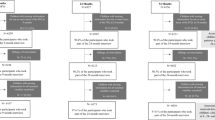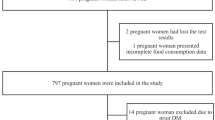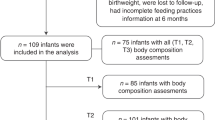Abstract
Background/Objectives:
Differences in the quality of complementary feeding between infants of obese and nonobese mothers have not been examined sufficiently. The aim of this paper was to compare dietary patterns, foods, nutrients and energy intakes of 9-month-old Danish infants in a cohort comprising obese mothers (SKOT II, n=184; SKOT, Danish abbreviation of small children's diet and well-being) with a cohort consisting mainly of nonobese mothers (SKOT I, n=329).
Subjects/Methods:
Dietary intake was assessed by 7-day records, and dietary patterns were identified by principal component analysis.
Results:
SKOT I was characterized by a lower maternal body mass index (BMI) and a higher social class than SKOT II in relation to parental education and occupation. Infants in SKOT II had lower scores on a Health-Conscious Food pattern reflected at the food group level, for example, with lower intake of the food groups Fruit and Vegetable but higher intake of WheatBreadNoWholegrain in SKOT II compared with SKOT I. Moreover, SKOT II had shorter durations of breastfeeding, earlier introductions of complementary feeding, higher energy intake from protein but lower energy intakes from monounsaturated fatty acids and polyunsaturated fatty acids at 9 months. SKOT II had higher weight-for-age and length-for-age z-scores, but no differences in BMI z-scores, as compared with SKOT I at 9 months.
Conclusions:
Infants of obese mothers from a lower social class seem to have a less healthy diet and higher weight and length z-scores at 9 months. Therefore, the promotion of healthy complementary feeding might be beneficial for the prevention of health implications, such as obesity, later in life for these infants.
This is a preview of subscription content, access via your institution
Access options
Subscribe to this journal
Receive 12 print issues and online access
$259.00 per year
only $21.58 per issue
Buy this article
- Purchase on Springer Link
- Instant access to full article PDF
Prices may be subject to local taxes which are calculated during checkout



Similar content being viewed by others
References
Frias AE, Grove KL . Obesity: a transgenerational problem linked to nutrition during pregnancy. Semin Reprod Med 2012; 30: 472–478.
Harder T, Bergmann R, Kallischnigg G, Plagemann A . Duration of breastfeeding and risk of overweight: a meta-analysis. Am J Epidemiol 2005; 162: 397–403.
Durand EF, Logan C, Carruth A . Association of maternal obesity and childhood obesity: implications for healthcare providers. J Community Health Nurs 2007; 24: 167–176.
Thompson AL . Intergenerational impact of maternal obesity and postnatal feeding practices on pediatric obesity. Nutr Rev 2013; 71 (Suppl 1), S55–S61.
Baker JL, Michaelsen KF, Sorensen TI, Rasmussen KM . High prepregnant body mass index is associated with early termination of full and any breastfeeding in Danish women. Am J Clin Nutr 2007; 86: 404–411.
Lepe M, Bacardi GM, Castaneda-Gonzalez LM, Perez Morales ME, Jimenez CA . Effect of maternal obesity on lactation: systematic review. Nutr Hosp 2011; 26: 1266–1269.
Michaelsen KF, Greer FR . Protein needs early in life and long-term health. Am J Clin Nutr 2014; 99: 718S–722S.
Pearce J, Langley-Evans SC . The types of food introduced during complementary feeding and risk of childhood obesity: a systematic review. Int J Obes (Lond) 2013; 37: 477–485.
Kiefte-de Jong JC, de Vries JH, Bleeker SE, Jaddoe VW, Hofman A, Raat H et al. Socio-demographic and lifestyle determinants of 'Western-like' and 'Health conscious' dietary patterns in toddlers. Br J Nutr 2013; 109: 137–147.
Robinson S, Marriott L, Poole J, Crozier S, Broland S, Lawrence W et al. Dietary patterns in infancy: the importance of maternal and family influences on feeding practice. Br J Nutr 2007; 98: 1029–1037.
Smithers LG, Brazionis L, Golley RK, Mittinty MN, Northstone K, Emmett P et al. Associations between dietary patterns at 6 and 15 months of age and sociodemographic factors. Eur J Clin Nutr 2012; 66: 658–666.
Ystrom E, Niegel S, Vollrath ME . The impact of maternal negative affectivity on dietary patterns of 18-month-old children in the Norwegian Mother and Child Cohort Study. Matern Child Nutr 2009; 5: 234–242.
Madsen AL, Schack-Nielsen L, Larnkjaer A, Molgaard C, Michaelsen KF . Determinants of blood glucose and insulin in healthy 9-month-old term Danish infants; the SKOT cohort. Diabet Med 2010; 27: 1350–1357.
Renault KM, Norgaard K, Nilas L, Carlsen EM, Cortes D, Pryds O et al. The Treatment of Obese Pregnant Women (TOP) study: a randomized controlled trial of the effect of physical activity intervention assessed by pedometer with or without dietary intervention in obese pregnant women. Am J Obstet Gynecol 2014; 210: 134–139.
Carlsen EM, Kyhnaeb A, Renault KM, Cortes D, Michaelsen KF, Pryds O . Telephone-based support prolongs breastfeeding duration in obese women: a randomized trial. Am J Clin Nutr 2013; 98: 1226–1232.
Gondolf UH, Tetens I, Hills AP, Michaelsen KF, Trolle E . Validation of a pre-coded food record for infants and young children. Eur J Clin Nutr 2012; 66: 91–96.
Molander E, Virtanen S, Thorgeisdottir H, Aarum AKO, Mattisson I . Nordic Nutrition Recommendations 2012 Integrating Nutrition and Physical Activity. Nordic Council of Ministers: Copenhagen, Denmark, 2013.
Wells JC, Davies PS . Can body size predict infant energy requirements? Arch Dis Child 1999; 81: 429–430.
Michaelsen KF, Larsen PS, Thomsen BL, Samuelson G . The Copenhagen Cohort Study on Infant Nutrition and Growth: breast-milk intake, human milk macronutrient content, and influencing factors. Am J Clin Nutr 1994; 59: 600–611.
Statistics Denmark. Family income. Available at: http://www.dst.dk/en/Statistik/emner/indkomster/familieindkomster.aspx (accessed 6 December 2013).
World Health Organization. WHO Anthro and macros (3.2.2), 2011. Available at: http://www.who.int/childgrowth/software/en/ accessed 5 January 2011.
Cattell RB . The scree test for the number of factors. Multivar Behav Res 1966; 1: 245–276.
Brazionis L, Golley RK, Mittinty MN, Smithers LG, Emmett P, Northstone K et al. Characterization of transition diets spanning infancy and toddlerhood: a novel, multiple-time-point application of principal components analysis. Am J Clin Nutr 2012; 95: 1200–1208.
Fisk CM, Crozier SR, Inskip HM, Godfrey KM, Cooper C, Robinson SM . Influences on the quality of young children's diets: the importance of maternal food choices. Br J Nutr 2011; 105: 287–296.
Bell LK, Golley RK, Daniels L, Magarey AM . Dietary patterns of Australian children aged 14 and 24 months, and associations with socio-demographic factors and adiposity. Eur J Clin Nutr 2013; 67: 638–645.
Friedman LS, Lukyanova EM, Serdiuk A, Shkiryak-Nizhnyk ZA, Chislovska NV, Zvinchuk AV et al. Social–environmental factors associated with elevated body mass index in a Ukrainian cohort of children. Int J Pediatr Obes 2009; 4: 81–90.
Reilly JJ, Armstrong J, Dorosty AR, Emmett PM, Ness A, Rogers I et al. Early life risk factors for obesity in childhood: cohort study. BMJ 2005; 330: 1357.
Robinson SM, Marriott LD, Crozier SR, Harvey NC, Gale CR, Inskip HM et al. Variations in infant feeding practice are associated with body composition in childhood: a prospective cohort study. J Clin Endocrinol Metab 2009; 94: 2799–2805.
Poulsen A, Brot C, Scott A . Mad til spædbørn & småbørn-fra skemad til familiemad (Food for Infants and Toddlers-From Mashed Food to the Family's Food) [in Danish]. Komiteen for Sundhedsoplysning. Danish Health and Medicines Authority; Ministry of Food, Agriculture and Fisheries-Danish Veterinary and Food Administration: Copenhagen, Denmark, 2013.
Agostoni C, Decsi T, Fewtrell M, Goulet O, Kolacek S, Koletzko B et al. Complementary feeding: a commentary by the ESPGHAN Committee on Nutrition. J Pediatr Gastroenterol Nutr 2008; 46: 99–110.
Dewey KG . Is breastfeeding protective against child obesity? J Hum Lact 2003; 19: 9–18.
Weng SF, Redsell SA, Swift JA, Yang M, Glazebrook CP . Systematic review and meta-analyses of risk factors for childhood overweight identifiable during infancy. Arch Dis Child 2012; 97: 1019–1026.
Rising R, Lifshitz F . Relationship between maternal obesity and infant feeding-interactions. Nutr J 2005; 4: 17.
Trolle E, Gondolf UH, Ege M, Kørup K, Ygill KH, Christensen T . Danskernes kostvaner Spæd—og småbørn 2006–2007 (The National Dietary Survey; Infants and Toddlers 2006–2007) [in Danish]. DTU Food: Søborg, Denmark, 2013.
Koletzko B, von Kries R, Closa R, Escribano J, Scaglioni S, Giovannini M et al. Lower protein in infant formula is associated with lower weight up to age 2 y: a randomized clinical trial. Am J Clin Nutr 2009; 89: 1836–1845.
Ekholm O, Kjøller M, Davidsen M, Hesse U, Eriksen L, Christensen AI et al undhed og sygelighed i Danmark 2005 & udviklingen siden 1987 (Health and Diseases in Denmark 2005 & The Development Since 1987) [in Danish]. The Danish National Institute of Publich Health: Copenhagen, Denmark, 2006.
Statistics Denmark. Highest attained education of the population (15–69 years) by region, ancestry, education, age and sex. Available at: http://www.statistikbanken.dk/statbank5a/SelectVarVal/Define.asp?Maintable=KRHFU2&PLanguage=1 (accessed 7 April 2014).
Acknowledgements
We thank the children, families and project staff of the SKOT cohorts. KFM received grants from the Danish Directorate for Food, Fisheries and Agri Business to the SKOT I cohort as part of the project Complementary and Young Child Feeding (CYCF)—Impact on Short- and Long-Term Development and Health. KFM received grants from Aase and Ejnar Danielsens Foundation and Augustinus Foundation to SKOT II. Part of the SKOT II funding was also provided by the research program ‘Governing Obesity’ funded by the University of Copenhagen Excellence Program for Interdisciplinary Research (http://www.go.ku.dk).
Author Contributions
KFM, CM and AL designed the research; LBBA conducted the research, analyzed the data and wrote the paper; EMC designed and conducted the research; CBP and RB supported decisions during data analysis; and ET supported nutrition evaluations. All authors reviewed, contributed to and approved the final version of the manuscript.
Author information
Authors and Affiliations
Corresponding author
Ethics declarations
Competing interests
The authors declare no conflict of interest.
Rights and permissions
About this article
Cite this article
Andersen, L., Pipper, C., Trolle, E. et al. Maternal obesity and offspring dietary patterns at 9 months of age. Eur J Clin Nutr 69, 668–675 (2015). https://doi.org/10.1038/ejcn.2014.258
Received:
Revised:
Accepted:
Published:
Issue Date:
DOI: https://doi.org/10.1038/ejcn.2014.258
This article is cited by
-
Vitamin D status of 3-year-old children in Denmark: determinants and associations with bone mineralisation and blood lipids
European Journal of Nutrition (2023)
-
Wholegrain intake, growth and metabolic markers in Danish infants and toddlers: a longitudinal study
European Journal of Nutrition (2022)
-
Genetic predisposition to higher body fat yet lower cardiometabolic risk in children and adolescents
International Journal of Obesity (2019)
-
Genetic predisposition to adiposity is associated with increased objectively assessed sedentary time in young children
International Journal of Obesity (2018)



